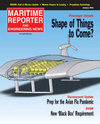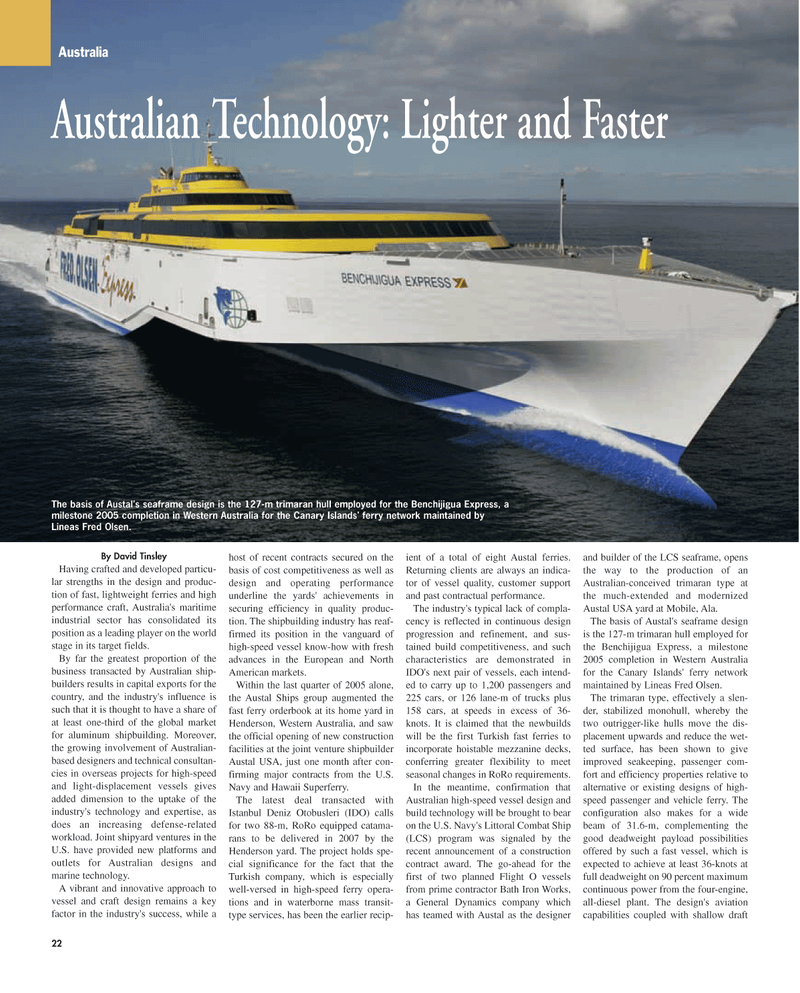
Page 22: of Maritime Reporter Magazine (January 2010)
Ship Repair & Conversion
Read this page in Pdf, Flash or Html5 edition of January 2010 Maritime Reporter Magazine
By David Tinsley
Having crafted and developed particu- lar strengths in the design and produc- tion of fast, lightweight ferries and high performance craft, Australia's maritime industrial sector has consolidated its position as a leading player on the world stage in its target fields.
By far the greatest proportion of the business transacted by Australian ship- builders results in capital exports for the country, and the industry's influence is such that it is thought to have a share of at least one-third of the global market for aluminum shipbuilding. Moreover, the growing involvement of Australian- based designers and technical consultan- cies in overseas projects for high-speed and light-displacement vessels gives added dimension to the uptake of the industry's technology and expertise, as does an increasing defense-related workload. Joint shipyard ventures in the
U.S. have provided new platforms and outlets for Australian designs and marine technology.
A vibrant and innovative approach to vessel and craft design remains a key factor in the industry's success, while a host of recent contracts secured on the basis of cost competitiveness as well as design and operating performance underline the yards' achievements in securing efficiency in quality produc- tion. The shipbuilding industry has reaf- firmed its position in the vanguard of high-speed vessel know-how with fresh advances in the European and North
American markets.
Within the last quarter of 2005 alone, the Austal Ships group augmented the fast ferry orderbook at its home yard in
Henderson, Western Australia, and saw the official opening of new construction facilities at the joint venture shipbuilder
Austal USA, just one month after con- firming major contracts from the U.S.
Navy and Hawaii Superferry.
The latest deal transacted with
Istanbul Deniz Otobusleri (IDO) calls for two 88-m, RoRo equipped catama- rans to be delivered in 2007 by the
Henderson yard. The project holds spe- cial significance for the fact that the
Turkish company, which is especially well-versed in high-speed ferry opera- tions and in waterborne mass transit- type services, has been the earlier recip- ient of a total of eight Austal ferries.
Returning clients are always an indica- tor of vessel quality, customer support and past contractual performance.
The industry's typical lack of compla- cency is reflected in continuous design progression and refinement, and sus- tained build competitiveness, and such characteristics are demonstrated in
IDO's next pair of vessels, each intend- ed to carry up to 1,200 passengers and 225 cars, or 126 lane-m of trucks plus 158 cars, at speeds in excess of 36- knots. It is claimed that the newbuilds will be the first Turkish fast ferries to incorporate hoistable mezzanine decks, conferring greater flexibility to meet seasonal changes in RoRo requirements.
In the meantime, confirmation that
Australian high-speed vessel design and build technology will be brought to bear on the U.S. Navy's Littoral Combat Ship (LCS) program was signaled by the recent announcement of a construction contract award. The go-ahead for the first of two planned Flight O vessels from prime contractor Bath Iron Works, a General Dynamics company which has teamed with Austal as the designer and builder of the LCS seaframe, opens the way to the production of an
Australian-conceived trimaran type at the much-extended and modernized
Austal USA yard at Mobile, Ala.
The basis of Austal's seaframe design is the 127-m trimaran hull employed for the Benchijigua Express, a milestone 2005 completion in Western Australia for the Canary Islands' ferry network maintained by Lineas Fred Olsen.
The trimaran type, effectively a slen- der, stabilized monohull, whereby the two outrigger-like hulls move the dis- placement upwards and reduce the wet- ted surface, has been shown to give improved seakeeping, passenger com- fort and efficiency properties relative to alternative or existing designs of high- speed passenger and vehicle ferry. The configuration also makes for a wide beam of 31.6-m, complementing the good deadweight payload possibilities offered by such a fast vessel, which is expected to achieve at least 36-knots at full deadweight on 90 percent maximum continuous power from the four-engine, all-diesel plant. The design's aviation capabilities coupled with shallow draft 22
Australia
Australian Technology: Lighter and Faster
The basis of Austal's seaframe design is the 127-m trimaran hull employed for the Benchijigua Express, a milestone 2005 completion in Western Australia for the Canary Islands' ferry network maintained by
Lineas Fred Olsen.
MR JANUARY2006 #3 (17-24).qxd 1/3/2006 3:11 PM Page 22

 21
21

 23
23
